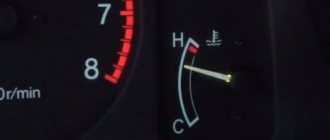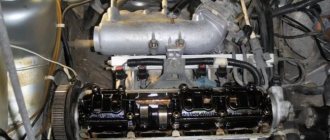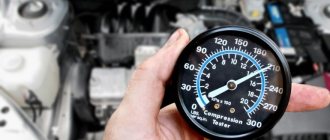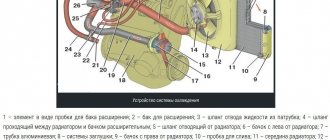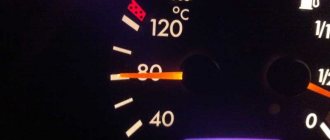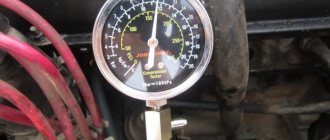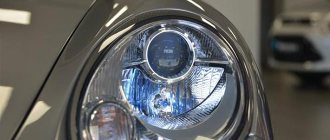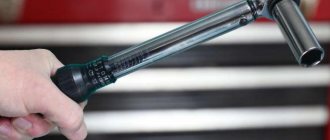The operating temperature of the engine in a Lada Granta car should be 90 degrees , but most owners complain that the temperature does not rise above 80 degrees . Even despite the above-zero temperature outside.
Apparently AvtoVAZ decided to further protect itself by installing a thermostat that opens already at 85°. The most interesting thing is that AvtoVAZ defines the tolerances for the opening temperature of the thermostat as: (85±8.3) ºС, i.e. from 77 to 93 ºС
. This is a scatter, isn't it?
The operating temperature of the engine must be at least 90ºС.
To learn how to find out the engine temperature when your car is not equipped with a temperature indicator on the instrument panel, read the material: how to check the engine temperature.
Operating temperature of 8-valve
The normal operating temperature for eight-valve engines on Kalinas and Grants is exactly 90 ºC . But owners complain that sometimes it has difficulty reaching 80 degrees even in warm weather. The reason lies in the thermostat - it opens fully at a temperature of 85 degrees. Moreover, the permissible deviation from this value is very large - ( 85±8.3 ) ºС.
In other words, the run-up is 77..93ºС .
But the fuel mixture can only ignite normally if the engine temperature is about 90 degrees . This is the value stored in the electronic control unit. If the temperature is too low, the mixture becomes richer (the amount of gasoline increases). This is the main problem that occurs when the temperature drops. And in winter the heater works worse.
Your case
Temperature diagram . Normal operating temperature is at 90 on the instrument panel.
In your case, the thermostat is most likely stuck, usually stuck in the middle. In this case, either repairing or replacing the thermostat will help.
A stuck thermostat valve is a typical malfunction of the engine cooling system.
That is, the liquid that has not yet been heated is supplied to the cooling radiator and blown by a strong wind flow. Indeed, with an increase in air temperature, the problem will partly go away. That’s why they used to put cardboard on it and drive like that for years. But we don't recommend doing this.
Solution
The problem of low temperature of the engine cooling system can be eliminated by installing a thermostat that opens at 92ºС . The WAHLER 3091.92D element performs excellently .
Original packaging of Wahler 3091.92d thermostat.
The element itself - the opening temperature is stamped on the body.
You just have to disassemble it and transfer the inside to Kalina’s original thermostat.
We saw off the plate, bend the body and take out the thermoelement.
We sharpen the spring so that the pressure point becomes flatter.
For comparison, thermoelements Wahler 3091.92d and the original one.
There is a downside: in summer the temperature will be higher, and there is a risk of boiling in a traffic jam. To be more precise, this risk is higher when installing a thermostat with a late opening time!
Be sure to use new gaskets and lubricate them with a small amount of sealant - this will prevent coolant leaks.
Causes of external overheating of the Kalina engine
Engine overheating can be caused by extremely low circulation of cold air inside the radiator. Most often this is due to the power supply to the ventilation system. In particular, the sensor that controls the speed of rotation of the blades fails. In this case, you need to check the degree of tension of the belt that connects the ventilation sensor and the crankshaft. If everything is in order with the belt drive, you need to pay attention to the level of contamination of the radiator and, if necessary, clean the unit. The above actions will be useless only if the radiator has completely outlived its useful life. In this case, the unit will need to be replaced with a new one.
Overheating can occur as a result of warping of the engine head seal or cylinder block lining. Other reasons: overheating or damage to the unit. If you do not contact a service station in time, there is a possibility of engine water hammer or crankshaft destruction.
The motor may overheat if the temperature sensor is faulty. Over time, sediment builds up in every cooling system, preventing the thermostat sensor from moving freely. Eventually it stops responding to the temperature level of the antifreeze inside the engine. In this case, the thermostat will circulate antifreeze through a small circuit, thereby reducing the cooling efficiency of the engine. This may not have any effect on the engine in the cold season, but in warmer weather the engine will overheat.
Another reason why the engine heats up may be excessive valve burnout. The fact is that the operation of the internal combustion engine is based on the principle of cyclical combustion of fuel, which passes processed gases through the hole in the exhaust valve. These gases have an elevated temperature, which affects the overall heating of the engine of domestic cars.
The Lada Kalina engine heats up very quickly when it is overloaded in certain situations. For example, a car is used as a means of towing another vehicle or trailer. In addition, during the warm season, many people go on vacation to mountainous areas. At high temperatures, lifting the vehicle will require increased torque, which is achieved at low speed. As a result, the cooling system reduces its efficiency and the engine overheats.
The same fate will befall a car that sits for a long time in a stuffy traffic jam in an urban environment. The air under the hood heats up, and the lack of movement eliminates the possibility of intensive circulation.
The cooling system (VAZ Lada Kalina) includes a number of functional elements:
- Engine cooling radiator. This unit is designed to reduce the temperature of heated antifreeze using a cold air flow.
- Radiator fan. This part performs the function of increasing the intensity of coolant cooling () in the system.
- Heater radiator. This is essentially a source of warm air for the car interior.
- Expansion tank. Since coolant tends to expand and contract with constant temperature fluctuations, this container serves to compensate for the volume of antifreeze in the system.
- Centrifugal pump or “pump”. This element carries out forced circulation of coolant through the channels of the vehicle system.
- Thermostat. This small, seemingly primitive part, performs a very important function: it regulates the required amount of antifreeze passing through the engine cooling radiator. Thanks to the thermostat, the most optimal temperature regime in the system is ensured.
- Coolant temperature sensor. This is one of the control elements of the ODS.
The engine cooling system diagram (Kalina 2117) is shown in the photo below:
Lada Granta: get inspected (VIDEO)
Lada Granta
Along the way, we invited readers to ask their questions about the Lada Granta. Having selected the most interesting ones, we asked AVTOVAZ representatives to answer them. Below you can see the plant workers' responses:
1. Lada Granta cars do not have a coolant temperature scale? Is the coolant temperature scale still necessary if the thermostat is defective? Do you plan to install a coolant temperature scale in the future?
Yes, on the “Norma” and “Standard” trim levels there is no dial gauge for the coolant temperature, but this does not interfere with the operation of the car. Let's imagine that the thermostat in a car is faulty. If it provides coolant current only in a large circle, there will be underheating, which can be easily detected by the “Check Engine” indicator (and, accordingly, during diagnostics), a constantly running engine cooling fan, or incorrect operation of the heater. If a faulty thermostat provides coolant current only in a “small circle”, the overheating danger indicator will sound (a red lamp on the instrument cluster and a buzzer), this is analogous to the “red zone” on the dial indicator. That is, the absence of a coolant temperature indicator does not affect the reliability of the car.
Lada Granta
2. Will there be a luxury instrument panel option (with dial indicators for temperature and fuel and a large screen in the center), but without GLONASS navigation?
Yes, a navigator will be offered as an option. In the basic version, the size of the LCD screen will be the same as on the Norma, but with an expanded set of functions. There will also be more alarms. There are no plans for dial gauges for fuel level and coolant temperature.
Lada Granta
3. There was a message that the buyer will have access to a set of options to order, in particular, air conditioning on versions below “Lux” - will this be implemented and if so, when? Will it be possible to produce the car in a pre-order configuration?
Engine temperature
Good afternoon, all forum members! I am a newbie car enthusiast, this is my first car, a Lada Kalina. Because I had no experience before, so I’m worried about the issue of engine temperature. We bought the car in September last year. In winter, at -30 with auto start, cold air blew from the stove until you started driving (you started the car with the key fob, after 15-20 minutes you got into it - there is a dud, cold air blows from the stove, and when you drive 200 meters it blows hot). At the same time, the engine temperature was always 70-90. We contacted REACTOR and they said we needed to change the thermostat. There was no money in winter (New Year holidays, etc.). They changed it only a month ago in April, + they immediately filled it with antifreeze (before that it turned out there was antifreeze). Then the car began to “warm up”, i.e. in first gear in traffic jams, and just while you’re standing at a traffic light, the temperature exceeds 100-105 (the fan comes on), and what can I say while driving – the temperature is 90-95, and while I’m parking backwards, it’s a minute at most, it reaches 105. Then my radiator pipes cracked, they were replaced and antifreeze was added again, but the temperature situation remained the same. Is this a normal temperature? I have nothing to compare with, I’m very worried that in the summer at +30 it will generally boil??? I kindly ask you to advise me on this matter. They just write everywhere and say that any car should keep the temperature at 90-92!!!
While warming up the car, you need to touch the pipes to see if the new thermostat is working properly. So that up to 70-80 degrees, the main radiator is cold, and after that it becomes as hot as the pipes to the stove. The thermostat could also be faulty. On my Kalina, the fan also turns on after 100 degrees. This is normal. But if you are worried about this, you can stop by and reflash the ECU to turn on earlier, for example at 98 degrees. It will be normal. How much mileage does the car have and have they changed the pump on it? The engine is 8 valve ,is there no air conditioning?
The fact that it gets hot in traffic jams is normal.
If the thermostat opens normally and the fan works, it will not boil. There was no need to change the thermostat - it had nothing to do with it. It’s just that at idle there was apparently not enough coolant pressure; the heater was not pumped well through the radiator. This is what they say happens on viburnums. Why, an acquaintance with a Mazda 3 2.0 even complained that his stove didn’t heat up at all when idling in cold weather.VAZ-2114 1.6 16V 98Hp 2010 Skoda Rapid FL 1.6 115Hp (cwvb + chip) 2022
I’m not sure about the pump, we didn’t change it exactly. The mileage we bought from her was 105... thousand, now it’s about 110... The engine is 8 valve, no air conditioning. The equipment is simple. A friend’s 12ka is heated thoroughly, he said when he bought it - it always kept exactly 90 +/-2 even at +35!!! And now it’s 100-110. So this is the norm that confuses me, that at +20 I’m already over a hundred or is there something wrong with the car???
Message from
Test PilotI’m not sure about the pump, we didn’t change it exactly. The mileage we bought from her was 105... thousand, now it’s about 110... The engine is 8 valve, no air conditioning. The equipment is simple. A friend’s 12ka is heated thoroughly, he said when he bought it - it always kept exactly 90 +/-2 even at +35!!! And now it’s 100-110. So this is the norm that confuses me, that at +20 I’m already over a hundred or is there something wrong with the car???
Even in winter, at -10 in traffic jams, it exceeds a hundred square meters and the fan turns on))
VAZ-2114 1.6 16V 98Hp 2010 Skoda Rapid FL 1.6 115Hp (cwvb + chip) 2022
Posted by
rmx116Even in winter, at -10 in traffic jams, it exceeds a hundred square meters and the fan turns on))
Those. is this normal for the car? It’s just that this is my FIRST car and I don’t know why or how. Those. I don’t have to worry, but in the summer at +30 it will just work constantly with the fan? Well, thanks for reassuring me, otherwise they write everywhere “normal temperature 90-92.” They also advise flushing the radiator
Everyone gets hot. As they wrote above, if the fan turns on and cools down, then there is no need to climb.
Message from
GRom 22ruseveryone's heating up
.as they wrote above, if the fan turns on and cools down, then there is no need to climb.
With a normal thermostat this is almost unnoticeable. My “Chinese child” worked well for a year, and now the temperature has also begun to grow slowly. Previously, it was clearly 89-90 according to the index in any heat, now it’s +20, and has already crept above 90.
I would advise installing the X1stat on-board computer on the Kalina, it costs 1k, everything is there, it also shows the temperature in numbers, the arrows are not informative at all, in my Prior the same problem started always above 90, I bought myself a BC, I’ll install it soon, I’ll know exactly how much) by ownership opts 14, the needle always went to the red zone, and according to the BC it showed no more than 100 degrees
I have a bortovik here. I set the temperature to 92 degrees.....in winter to 95. And in general, the standard switching temperature = 102 degrees, it seems like that’s what a friend said. There was a Niva Chevy, it also didn’t warm up well when starting up, but when driving – hello….. …and as for the cold air, is there a cabin filter??? can replace???
…”It’s better to be inept in a garage with a car than skillful with port wine in a gateway” (c)
Message from
Zero ColdI have a bortovik here. I set the temperature to 92 degrees.....in winter to 95. And in general, the standard switching temperature = 102 degrees, it seems like that’s what a friend said. There was a Niva Chevy, it also didn’t warm up well when starting up, but when driving – hello….. …and as for the cold air, is there a cabin filter??? can replace???
92 is not enough
Message from
Test PilotGood afternoon, all forum members! I am a newbie car enthusiast, this is my first car, a Lada Kalina. Because I had no experience before, so I’m worried about the issue of engine temperature. We bought the car in September last year. In winter, at -30 with auto start, cold air blew from the stove until you started driving (you started the car with the key fob, after 15-20 minutes you got into it - there is a dud, cold air blows from the stove, and when you drive 200 meters it blows hot). At the same time, the engine temperature was always 70-90. We contacted REACTOR and they said we needed to change the thermostat. There was no money in winter (New Year holidays, etc.). They changed it only a month ago in April, + they immediately filled it with antifreeze (before that it turned out there was antifreeze). Then the car began to “warm up”, i.e. in first gear in traffic jams, and just while you’re standing at a traffic light, the temperature exceeds 100-105 (the fan comes on), and what can I say while driving – the temperature is 90-95, and while I’m parking backwards, it’s a minute at most, it reaches 105. Then my radiator pipes cracked, they were replaced and antifreeze was added again, but the temperature situation remained the same. Is this a normal temperature? I have nothing to compare with, I’m very worried that in the summer at +30 it will generally boil??? I kindly ask you to advise me on this matter. They just write everywhere and say that any car should keep the temperature at 90-92!!!
put a Bosch electric pump on the stove
Posted by
Nemez0092 is not enough
can I give you a detailed answer...why?????
…”It’s better to be inept in a garage with a car than skillful with port wine in a gateway” (c)
Message from
Zero Coldcan I give you a detailed answer...why?????
What's the point of this? designers raise the temperature to increase efficiency if the expander plug is in working order, the boiling temperature is around 110, make it 97 and this will be enough, you won’t boil and the engine will work in optimal mode. I did the same for myself. I don’t tighten the plug.
Message from
Zero Coldcan I give you a detailed answer...why?????
even the operating temperature of the engine, as specified by the factory, seems to be around 98 degrees. and with 92, in the summer, Carlson will not shut up at all.
Posted by
Nemez00do 97 and this will be enough, you won’t boil and the engine will work in optimal mode, I did the same for myself. I don’t tighten the plug
But what about the recommended PRESSURE IN THE SYSTEM
Message from
GRom 22rus
even the operating temperature of the engine, as specified by the factory, seems to be around 98 degrees. and with 92, in the summer, Carlson will not shut up at all.
well, yes, well, yes...Syonya is often often on.....
…”It’s better to be inept in a garage with a car than skillful with port wine in a gateway” (c)
I know some people throw the check valve out of the cap so that there is no pressure
…”It’s better to be inept in a garage with a car than skillful with port wine in a gateway” (c)
Message from
Zero ColdBut what about the recommended PRESSURE IN THE SYSTEM
it is needed to prevent the antifreeze from boiling. I lowered the Carlson switch-on temperature. The cork won’t boil because it’s not reliable. It’s better to be safe than sorry. You can buy a high-quality cork. This is unreal)))
Posted by
Nemez00it is needed to prevent the antifreeze from boiling. I lowered the Carlson switch-on temperature. The cork won’t boil because it’s not reliable. It’s better to be safe than sorry. You can buy a high-quality cork. This is unreal)))
those. The best option is to remove the valve from the cover and set the Carlson to 97 degrees???
…”It’s better to be inept in a garage with a car than skillful with port wine in a gateway” (c)
Message from
Zero Coldthose. The best option is to remove the valve from the cover and set the Carlson to 97 degrees???
The best option is to drive with a working system. This is not always possible. A faulty valve will create problems in the form of a leaking radiator. better to be on the safe side))) in this version without a valve and 97 degrees
Why does a 16 valve engine take a long time to warm up?
- Registration
- Entrance
- To the beginning of the forum
- Forum Rules
- Old design
- FAQ
- Search
- Users
People, the car is VAZ-2112. The following problems arose with warming up: the temperature outside was -15 degrees, it started without problems, it warmed up to 30-40 degrees quite quickly at idle, then driving. Even during a long drive around the city, the temperature does not rise above 79-81 degrees, it heats up slowly, i.e. in about 20 minutes of driving it reaches 80 and stabilizes. At the same time, the stove works perfectly and at some point even stops turning the fan altogether.
What is this - a bug or a feature of the 16 valve engine? And if these are problems, what are they: is the thermostat or temperature sensor going crazy, what should I even look at?
But then why can it hang at 80 degrees for as long as desired? A friend of mine at work has a VAZ 21102 - while he drives to work (20 minutes) the engine turns 90 degrees, so I decided to ask.
When you use a mercury thermometer to measure the temperature in identically heated cars in the same place, then you can judge the operation of the thermostat. The temperature sensor readings for the instrument scale may vary with an error of +5 - -10%. So think about what this means. Draw your own conclusion too.
I'm looking at the on-board computer. That’s why this question arose, but my dashboard is completely lying and doesn’t turn red: when it shows 50, then the on-board readings are already 70-80.
Using the BC readings, you can quite accurately determine the temperature at which the large circle begins to open. Your thermostat valve appears to be opening earlier than it should.
I'm looking at the on-board computer. That’s why this question arose, but my dashboard is completely lying and doesn’t turn red: when it shows 50, then the on-board readings are already 70-80.
Using the BC readings, you can quite accurately determine the temperature at which the large circle begins to open. Your thermostat valve appears to be opening earlier than it should.
And that the on-board computer does not take the temperature from the same sensor? I always thought it was from there.
Well, okay, I'll get back from work in the evening and dig into the electrical circuit.
By the way, since the question is about the temperature regime of the engine, can you also clarify what are the temperature parameters for turning the cooling fan on and off?
I don’t remember at what specific temperature the fan turns on and off, but the controller takes the data for this from the temperature sensor screwed into the thermostat.
2 VadiK_055
Everything is normal for you (2112 engines heat up while driving much slower than 2111 engines), except for the value at which the coolant temperature stabilizes. Very similar to early opening of the thermostat. In general, in winter, with prolonged uniform movement, the coolant temperature stabilizes at the temperature at which the thermostat begins to open. During city driving, however, this does not work; in the city you can drive until the Carlson triggers. You can check the operation of the thermostat during warm-up after a long period of parking by feeling the pipe extending from the thermostat to the bottom of the radiator. You need to feel 5-10 cm from the thermostat itself. The temperature at which the pipe begins to warm is the temperature at which the thermostat begins to open. The method is not very accurate, but it allows you to evaluate the operation of the thermostat.
The on-board computer takes temperature readings not from the sensor at all, but from the controller. That, in turn, receives data from the sensor. There are two sensors, one provides information to the display meter in the instrument panel, the other to the controller. A bookmaker, in general, can be called a computer very conditionally. The simplest ones can only calculate fuel consumption according to the controller data and nothing more. Everything else they simply INDICATE. Indicate data received from the controller. Well, I got distracted.
The 2112 engine has a radiator fan turn-on temperature of 100 degrees and a turn-off temperature of 96 degrees. It seems that on the old firmware there were 101 and 97, but I don’t know for sure.
_________________I'm not WEAK-willed, I'm STRONGLY lazy.
I do this: - go into the garage (unheated brick, but it’s still warmer there than outside) - start the car (2112 16V) - open the garage, roll out, close the garage (6-7 minutes), the temperature rises by this time to 50 -55 degrees
The importance of using antifreeze
Monitor the antifreeze level
External engine overheating can occur for a number of reasons, and one of the main ones is insufficient antifreeze in the cooling system. Antifreeze can leak out easily because it has the structure of a regular liquid. Therefore, it is necessary to constantly monitor the integrity of the hoses and their fastenings.
Try to pay attention to the surface where the car has been standing for a long time. Light spots on it indicate a coolant leak. If such signs are detected, it is necessary to urgently check the integrity of all elements of the cooling system. If antifreeze leaks into one of the engine cylinders or into the oil compartment, serious complications are quite possible.
If you do not use antifreeze, but fill the cooling system with distilled water, you should not use hard water, which contains a large amount of minerals and salts. You risk ruining even a new thermostat after only 3-4 thousand kilometers.
What to do if your car overheats in a traffic jam
When driving a car for a long time in a lower gear, the engine operates with increased power, which in itself leads to overheating. Add to this the lack of counter-flow of air necessary to cool the radiator. What to do? The main thing is not to panic. Short-term overheating is not terrible, but if you see that the car is not cooling down, it’s time to act.
Important - do not turn off the engine unless absolutely necessary. Exactly - without extreme
A stalled, overheated engine is an almost 100% guarantee of repair. It will take quite a long time to describe what is happening in the engine in this case (rotating the liners together with the crankshaft, when the engine is subsequently started - the least of the possible troubles), just take it on faith.
Important - do not think about pouring water on the engine or pouring cold water into the radiator. The result is the same - repair
Moreover, you can try so hard that you cannot do without replacing the block and cylinder head. Another “beauty” of cold water is microcracks inside the block. Finding and eliminating will be very, very difficult, if not impossible. The car has overheated - try to pull over to the side of the road. If it doesn’t work out, don’t panic and don’t pay attention to those around you – it’s important for you to save the engine. Stop at idle, turn the heater on full, and wait. If after 5-10 minutes the situation does not improve, turn off the engine. It’s a good idea to open the hood; the main thing in a panic is not to forget to set the car’s parking brake.
The only reason to turn off the engine right away is clouds of steam coming from under the hood. Most likely, the cooling pipe has burst, and further operation of the engine will only worsen the situation.
Video
The car engine is overheating.
Overheating of a car engine is a problem that every driver can face. In this article we can learn: - how to notice in time that the engine has overheated; — why the engine heats up in general and in certain situations; — what to do if the engine overheats.
To understand the essence of the issue, it is necessary to consistently read all the explanations of an experienced auto mechanic.
So where should you start?
The first thing you need to do is check the antifreeze level in the system. To do this, open the hood and look at the expansion tank. Ideally, it should be filled to ½ of the total volume. If necessary, add coolant to this level.
If you find an antifreeze leak, then inspect the engine compartment of the car - there may be leaks here.
At what temperature does the fan turn on?
Lately I have to drive my Kalina quite rarely, and I noticed a peculiarity that the fan does not turn on at all. Although you have to stand in traffic jams, and the temperature outside is above +30 degrees. We began to have doubts about the performance of the fan or the electrics responsible for its operation. I decided to check everything at idle when the car was parked. I started it up and waited until the engine warmed up to a high temperature. At this time, I opened the hood and began to observe the fan. After about 20 minutes of engine operation, the coolant temperature gauge needle approached 100 degrees, but the fan still did not want to turn on.
Heat
If the engine temperature is too high, then you need to look for the cause of the breakdown. May work poorly:
Driving with an engine that is constantly heating up is even more dangerous than driving with an engine that is not warm enough. Therefore, all causes of overheating must be eliminated in a timely manner.
The following two tabs change content below.
- About the author:
- Latest articles:
I am the editor-in-chief of the site. In our editorial office: Hyundai Accent, Hyundai Solaris, Hyundai Santa FE (turbo-diesel 2015). I now have a Lada Kalina LUX (98 horses). A car fanatic, he has owned both left and right hand drive cars. Robots, CVTs, mechanics. The only thing missing was DSG. But it will be soon.
Similar materials
Tags: Questions Lada KalinaLada Kalina
What is the operating temperature of the Lada Kalina engine?
Normal operating temperature of internal combustion engine: +90. +95, if above +97 then the internal combustion engine will be slightly dulled, but this t is also considered normal, up to +110 is also normal, but the radiator fan should already turn on. If t is below +90, this is not overheating. We look at the thermoelement for grinding into the thermostat cover (so that when closed it does not etch into a large circle) and the serviceability of the thermoelement itself by boiling it in the thermostat cover. If the lower pipe is cold, this is not a fact that it does not poison the large circle.
Here, for example, is my excerpt from the topic: SOD according to Kalinovsky:
I purchased a 6-hole thermostat assembled, sealed, with an Quality Control Department stamp, t 85, PRAMO, for 505 rubles. I also had a thermocouple from a viburnum, also at t 85, lying around for a long time. ___________________________________________
Kalinovsky thermoelement:
__________________________________________________
Thermostat with thermocouple:
__________________________________________________
I boiled both thermoelements in this one housing of the new thermostat, the result:
1. Thermoelement from viburnum: opened slightly at +92 (began to let water through at atmospheric pressure) at 96 opened slightly by 5 mm +100 opened by 8-9 mm diluted the water to +83 - almost instantaneous slamming.
2. Stock thermocouple Pramo: opened slightly at exactly +85 and went at atm. pressure +86 hole mm 2-3 +88 hole approximately mm 5 diluted the water to +83 - it slows down for about a minute.
Now do you understand why your operating temperature in winter is +88 and below?
There was a thermoelement left from the new PRAMO thermostat, which turned out to be a little longer (rod) and did not fit tightly into the cover of the Priora thermostat. The cover of the Priorov thermostat was drilled out a little and the thermoelement sat tightly, now it is not blown through. (before these actions I thought about it, I didn’t sit down by two mm)
Boiling, video 5:52, 24.4 MB, heating and cooling processes:
via FTP video 5:52, 24.4 MB _______________________________________________________________
And now the sea trials of the Kalina thermoelement with the Pramo cover:
In weather -15, VideoAdded t coolant on the move, t air in the driver's compartment, t air flow at the carrier's feet
(16.6 MB)
Via FTP, 16.6 MB ________________________________________________________________
Warming up from a cold start, with on. stove, -16 on the street, -15 coolant, -15 in the cabin, at XX, 24 minutes: here is the video, 63.4 MB:
Warming up from a cold start, with off. stove, -19 on the street, -18 coolant, -17 in the cabin, at XX, 23 minutes: here is the video, 30.4 MB:
After a year, RESULT: Summer is working. temperature +92. +94 (tested at temperatures up to +35 C) Winter working. temperature +90. +92 (tested at temperatures down to -41 C)
Temperature regime of the Kalina 2 16 valve engine with air conditioning
I’m creating a topic in this section because in the technical section all similar topics are mainly about SOD problems on LK1. If moderators are wrong, please move it.
So the problem I have is that, compared to the LK1, which had the 21126 engine, the new Viburnum, with the 21127 engine, takes a very long time to warm up to operating temperature and in general the engine temperature does not exceed 80 degrees at an outboard temperature of -1 to -10. Moreover, it stays strictly in the corridor of 79-82 degrees, when driving both in the city and on the highway. When parked with the engine running, very slowly, but it warms up to 100 degrees, then the fan turns on and quickly brings it down to 85. In the mornings it takes a very long time to warm up, at a starting coolant temperature of -10 to +40 it warms up for about 7-10 minutes, after that I start moving and only after 15 minutes of driving around the city, the temperature somehow reaches 65-70 and then slowly approaches 80 degrees where it freezes.
Description
As you know, any Priora and Kalina have a cooling system that ensures normal engine operation and helps prevent overheating. One of the devices that allows you to cool the power unit is a fan sensor, upon the signal of which the ventilation device should turn on. On Kalina, this controller is designed to activate the fan when the engine temperature reaches a certain point. Thanks to the fan, which must turn on based on a signal from the controller, the engine temperature will always be normal and will not exceed the permissible threshold. If the device does not work, the fan will not turn on, and the engine may overheat.
Sensor connection diagram in the cooling system
If overheating occurs
When your engine suddenly overheats or your cooling system suddenly stops working, the following actions can prevent catastrophic consequences.
If you can park safely on the side of the road, park right next to the curb and turn off the engine. As soon as the engine temperature arrow has left the danger zone, and the temperature is in optimal values, you can continue driving.
To help your unit return to normal faster, it is better to open the hood. This way the heat can escape very quickly. You should do this extremely carefully - there is a risk of getting burned.
There is no need to attempt to open the radiator cap. If you open it, steam and coolant will come out of the radiator. It is under pressure - you could be seriously injured.
The temperature needle drops. Why?
The most common problems are when the temperature of the unit increases uncontrollably, reaching critical values. The cause of overheating is a jammed thermostat, which does not allow the coolant to pass through the radiator. The heated antifreeze continues to circulate in a small circle until it boils.
The opposite situation often occurs when the engine temperature gauge drops while driving. Why? The point, again, is the quality of operation of the mentioned valve. If the thermostat cannot close all the way, allowing the fluid to continuously circulate in a large circle, the engine will not warm up to its operating temperature.
Sometimes the thermostat gets stuck after the engine has warmed up. When this happens, the driver may notice that the engine temperature drops while driving, although it should be maintained at a consistently even, operating level.
Sometimes the temperature regime changes abruptly, sometimes increases, sometimes decreases sharply. This means that the valve periodically jams, and the driver will notice a situation where the temperature arrow periodically drops.
Which thermostats to choose for VAZ (Lada) Kalina?
Last month, PartReview users preferred WEEN. 29% of positive votes belong to this manufacturer.
LUZAR thermostats took second place – 14%.
Gates closes the top three with 4% of the votes.
In the general rating of thermostats, which takes into account the opinions of owners of different brands and models of cars, these brands occupy the following positions:
- WEEN received 1st place, PR score – 91. Data from 36 reviews and 111 votes are taken into account.
- LUZAR took 7th place, with a PR score of 66. Based on 36 reviews and 186 votes.
- Gates is ranked 9th with a PR score of 53, based on 24 reviews and 73 votes.
Cooling scheme
The cooling scheme of the Lada Kalina 8 valves is quite simple. The entire system consists of several fundamental elements that are interconnected. The Lada Kalina power unit has a cooling system with two circles - small and large. The first is designed to warm up the engine, but the second is to provide cooling.
The Lada Kalina engine cooling system has the following diagram.
Replacing coolant temperature sensors on Kalina
Welcome! Coolant temperature sensors - if we talk specifically about the Lada Kalina car, then there are only two sensor data in it, one goes to the controller (This is the brain, to put it simply), and the other to the device, that is, one sensor shows what the temperature of the coolant in the car is and displays this is all for the device, and another one (which gives readings to the controller) turns on the cooling system fan when the car is boiling, and also regulates the fuel-air mixture (Simply put, when the car is cold, thanks to this sensor it will warm up faster, because the sensor richens the mixture and the temperature immediately rises), both of these sensors are important and if they fail they will cause quite a lot of trouble, especially for the sensor that gives readings to the device, if it stops working, then you simply will not know the temperature of the coolant and in connection with which you can overheat the engine.
Note! To replace both sensors (you will most likely only replace one), stock up on: Wrenches, as well as sockets and a wrench for them, you will also need a multi-meter (This is in case you want to check the functionality of the old sensor ) and a screwdriver!
- Replacing coolant temperature sensors
- Additional video clip
Where are the coolant temperature sensors located? We would like to immediately note one very important fact, just below we have posted a photo in which we have already indicated with arrows the location of both sensors, but the photo shows a VAZ 2110 car, and you have a Lada Kalina, in general there is not much difference in the engines and these sensors are also on them are located practically in the same places, we just wanted to warn you so that you are not too surprised when you look at your engine, because they may differ slightly, but in general, as already said, they are almost the same, in general the sensor that measures coolant temperature and gives it to the controller, screwed into the thermostat and indicated by a red arrow, the second sensor that gives readings to the device is already indicated by a green arrow, but since it is not visible in the photo, we also indicated with a blue arrow the wire that is connected to this sensor .
When should coolant temperature sensors be replaced? The sensors themselves should last quite a long time, but they don’t always come across high-quality ones, and even literally after a month new sensors already fail, it’s not difficult to understand this, especially if it’s a sensor that goes to the device (the gauge will immediately stop showing the coolant temperature, the arrow will just will lie, for clarity this indicator is indicated by an arrow), but with the sensor that goes to the controller it’s a little more complicated and you won’t even immediately understand that it’s time to change it, well, let’s move on to the symptoms, firstly, if the sensor going to the controller comes in unusable, then the car will consume more gasoline (This is due to the fact that the mixture will always be rich) and the cooling fan will not work when the engine overheats, if you notice all this in your car, then immediately change the sensor to a new one or simply remove the old one and check it (we explained in this article a little lower how both sensors are checked, so read it and you will understand everything as you read).
Replacing the thermostat
On the automotive spare parts market you can find a large number of thermostats from various manufacturers; their cost varies from 400 to 700 rubles. When choosing, it is better to stick to original AvtoVAZ spare parts. Catalog article number for the standard thermostat on Kalina – 1118-1306010
Of the analogues, “Luzar” and “Pramo” have proven themselves well, but the first is often counterfeited, and the second has poor quality - the service life is on average about a year. The original device, which is installed from the factory, can last more than three years
Replacing a thermostat on Kalina with 8 valves or 16 is estimated at no more than 800 rubles, including removing air from the system. To avoid paying twice, you can change the part yourself. Just before this, you should check the device for functionality using the described methods.
What tools will you need?
To operate, you will need a working thermostat and a suitable container for draining the coolant from the SOD - a regular five-liter plastic bottle. The differences between replacements on an 8- and 16-valve engine are insignificant. On the latter, you will need to additionally remove the starter so as not to accidentally fill it with antifreeze. The rest of the procedure is similar.
To remove the assembly, you will need two socket wrenches, 13 mm and 12 mm, since Kalina uses nuts of different sizes.
Replacement instructions
The replacement process is not complicated and can be done independently if you follow the instructions. First you need to disconnect the wire plug from the sensor on the air filter and remove it. It will take a few minutes to properly dismantle the filter:
- the two upper screws are completely unscrewed together with the nut from the power unit side;
- there is a recirculation valve on the filter housing; it must also be removed;
- lift the valve up and, without disconnecting the hoses, move it to the side;
- unplug the terminal from the air sensor and, loosening the clamps, disconnect the air pipe;
- After shaking the filter from side to side, turn its housing and try to pull it out.
Further procedure:
- Drain the coolant from the system.
- Using an 8 mm wrench or a shaped screwdriver, loosen all the clamps of all connecting hoses, then disconnect them.
- Unscrew the 12 mm nut on the thermostat and remove the wire.
- Using a 13 mm wrench, unscrew the fastening nut at the top and bottom of the thermostat on the studs, then try to remove the device by slightly loosening it. You don't need to make a lot of effort for this. Keep in mind that the thermostat operates at high temperatures, due to which the housing literally “sticks” to the seat.
- Clean the seat from dirt and remove the old sealing gasket. Then wipe the treated area with a clean rag, apply a thin layer of silicone cover and leave for 5-10 minutes.
- The new thermostat is installed in the reverse order. You should definitely replace the temperature sensor by removing it from the old device, and do not forget to connect the ground wire. To do this, it is fixed with a nut on the upper stud.
- Connect all hoses and fill the system with coolant to the maximum level.
After completing these steps, you need to start the engine and inspect all the places that were disconnected. You can make sure there are no leaks by lightly pressing all the hoses several times. The liquid level in the tank will drop, then you need to add antifreeze to the middle mark and screw the cap tightly.
Control check
After completing the work to replace the part, the problem with overheating or long warm-up should disappear. It remains to check the correct functioning of the thermostat
To do this, periodically you need to pay attention to the temperature indicator arrow. If it does not rise above 90-95 degrees, then the system is working normally
When replacing, you should take into account the specific temperature conditions of the products - it can be either lower or higher than average.
When carrying out vehicle maintenance, the thermostat must also be inspected, despite the fact that this is not included in the regulations. Timely replacement of a faulty device will prevent premature wear of engine parts and prevent overheating of the power plant. A small device with one valve can affect the functioning of the entire heat removal system from the internal combustion engine.
We recommend reading:
- Rear wheel bearing on Lada Kalina: we change it ourselves
- Do-it-yourself stove on Kalina: replacing the radiator and fan
- Main functions of the resonator on Kalina
- We buy a muffler for Kalina
- Replacing the fuel filter on Lada Kalina
- Instructions for replacing tie rod ends on Lada Kalina
